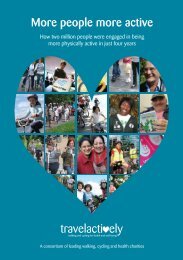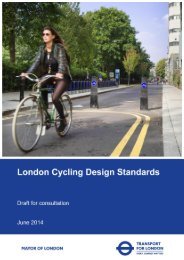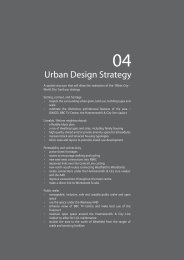Travel in London Travel in London
travel-in-london-report-8
travel-in-london-report-8
Create successful ePaper yourself
Turn your PDF publications into a flip-book with our unique Google optimized e-Paper software.
5. Operational efficiency, public transport fares, asset condition and payment technologies<br />
5. Operational efficiency, public transport fares,<br />
asset condition and payment technologies<br />
5.1 Introduction and contents<br />
The preced<strong>in</strong>g chapters have looked <strong>in</strong> detail at trends <strong>in</strong> travel demand and<br />
transport operational performance <strong>in</strong> <strong>London</strong>, thereby quantify<strong>in</strong>g the chang<strong>in</strong>g<br />
context and background to the MTS, <strong>in</strong> terms of aggregate travel demand and<br />
transport supply.<br />
The follow<strong>in</strong>g six chapters cover the wider canvass of MTS objectives. This chapter<br />
looks at aspects of TfL’s operational efficiency, cover<strong>in</strong>g outcomes relat<strong>in</strong>g to TfL’s<br />
operat<strong>in</strong>g costs and asset management, trends <strong>in</strong> public transport fares levels and<br />
chang<strong>in</strong>g payment technologies.<br />
5.2 Key trends – operat<strong>in</strong>g costs, asset condition and public<br />
transport fares<br />
Over the period s<strong>in</strong>ce 2008/09, TfL has significantly reduced operat<strong>in</strong>g costs per<br />
passenger kilometre, reflect<strong>in</strong>g real efficiencies <strong>in</strong> operations and the strong growth<br />
<strong>in</strong> patronage on the public transport networks. Asset condition, <strong>in</strong> terms of the<br />
average age of key assets, has been ma<strong>in</strong>ta<strong>in</strong>ed, although very significant ‘step’<br />
changes such as the wholesale replacement of the tra<strong>in</strong> fleet on the sub-surface<br />
Underground l<strong>in</strong>es, are counterbalanced by the wider age<strong>in</strong>g process that affects all<br />
of TfL’s assets. This highlights the po<strong>in</strong>t that cont<strong>in</strong>ued <strong>in</strong>vestment is needed just<br />
to stand still.<br />
• TfL’s operat<strong>in</strong>g costs, measured <strong>in</strong> passenger kilometre terms, reduced over the<br />
period between 2010/11 to 2014/15 – that for which comparable<br />
measurements are available. This reflects both actual efficiencies <strong>in</strong> terms of<br />
how TfL provides and operates services, but also a rapid growth <strong>in</strong> passenger<br />
demand.<br />
• Gross expenditure on operat<strong>in</strong>g services <strong>in</strong> 2014/15 was £4.7bn, compared with<br />
£4.1bn <strong>in</strong> 2010/11, with gross operat<strong>in</strong>g costs per passenger kilometre of 23<br />
pence respectively. In terms of net expenditure, TfL spent £401m <strong>in</strong> 2014/15<br />
(equivalent to 2 pence per passenger kilometre) aga<strong>in</strong>st £702m <strong>in</strong> 2010/11<br />
(equivalent to 4 pence per passenger kilometre). Passenger kilometres grew by<br />
15 per cent over this period.<br />
• TfL is a public body, with no shareholders or parent companies, which means<br />
we can re<strong>in</strong>vest all surplus <strong>in</strong>come <strong>in</strong> the transport network. For every pound we<br />
receive, 65 per cent is spent on operat<strong>in</strong>g the network, and 35 per cent on<br />
improv<strong>in</strong>g it for the future.<br />
• The percentage of TfL’s key assets deemed to be <strong>in</strong> ‘good’ condition (this<br />
measure ma<strong>in</strong>ly relates to asset age and not to safety-critical aspects) has been<br />
ma<strong>in</strong>ta<strong>in</strong>ed at around 90 per cent consistently over the period s<strong>in</strong>ce 2008. This<br />
reflects cont<strong>in</strong>ued <strong>in</strong>vestment <strong>in</strong> new <strong>in</strong>frastructure and the <strong>in</strong>evitable fact that<br />
all assets age with the passage of time.<br />
• Real public transport fare levels <strong>in</strong>creased <strong>in</strong> the latter years of the last decade<br />
but have been relatively stable over more recent years. Real fares <strong>in</strong> 2014, based<br />
on a weighted average <strong>in</strong>dicator across the ma<strong>in</strong> public transport networks,<br />
97 <strong>Travel</strong> <strong>in</strong> <strong>London</strong>, Report 8








